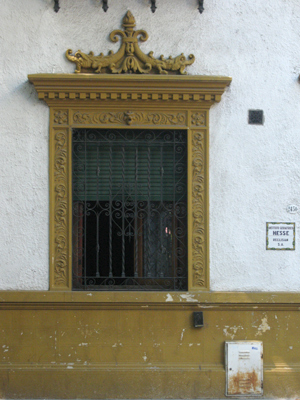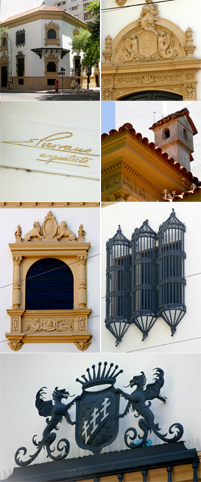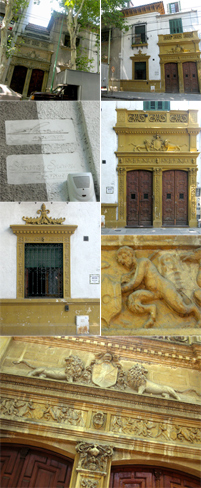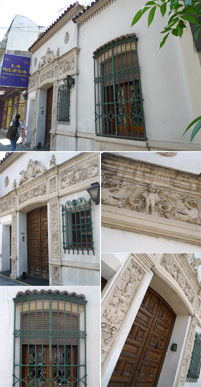
Coexisting with Art Deco & English Revival styles in the 1920’s was an idealized notion of Spanish architecture during colonial times. Certainly influenced by the 1929 Ibero-American Exposition, this style of architecture never existed in Buenos Aires prior to the 20th century. Ochre & white colors echo those of Sevilla, & delicate designs in columns & panels are inspired by a late Gothic-early Renaissance Spanish style known as plateresco. Derived from the Spanish word for silver (plata), the decoration mimics silver filigree work. Add to all of this a new interest in Spanish Mission architecture from California & you have the beginning of Latin American movement in architecture. Estanislao Pirovano joined the club.
Mendoza & O’Higgins (Belgrano) • Predominantly Neocolonial with an odd bit of Tudor Revival thrown in, it seems like Pirovano couldn’t stick to just one style. Note that the doors are not the wide, four-centered arch he usually designed, but the Tudor comes out with a coat-of-arms & a knight. There’s a lot going on here… mermaids with wings instead of arms add to the eclectic appearance. Most of the windows are carbon copies of each other with a set of lions flanking another coat-of-arms & a plateresco dragon. In fact, there is lots of plateresco all over this building… something that Pirovano didn’t seem to adopt until his later years. Two things stand out here that Pirovano didn’t use anywhere else: wrought-iron dragons above the windows & a funky, bird cage window decoration (almost an exact copy of the window on the Casa de las Conchas in Salamanca, Spain). I bet this building looks spectacular on the inside. I need an invitation!
Bogotá 2442/2450 (Flores) • This was the first duplex I’d seen by Pirovano & probably the only thing he built in Flores. Not sure if there are any more like this in Buenos Aires, but I liked it… in spite of the poor maintenance of the building. These are not very good pics due to the backlight & the truck. Oh well.
The left house looks original while the right one (now a retirement home) has been substantially modified. Beyond a coat of paint, it looks like the right house had the second-story window extended, the balcony above the doors enclosed & new roof tiles installed. It might appear to be in better condition, but closer examination revealed a very heavy coat of paint that covers up tiny details. Gotta love those doors though.
Lack of care during “restoration” is most visible with the Pirovano signature. Stamped in the middle of the building between properties, it looks like it was damaged & someone came along who tried to copy Pirovano’s handwriting. I preferred the older, original side because the Neoplateresco really stands out… goat-men fighting mere mortals & soldiers heads sticking out everywhere. The only bit of Tudor is lions with a single coat-of-arms above the two doors.
Lafinur 2988 (Palermo) • Under restoration for a good part of 2007 & 2008, I’ve yet to return to photograph the results. These photos will have to do for now. The Carabassa family mansion was remodeled by Pirovano in 1923 to incorporate many of his favorite themes: Neocolonial images, Neoplateresco & a whole lot of dragons. The building went through other uses & was eventually purchased by the Fundación Eva Perón to use as a shelter. In 2002, they converted the mansion into a museum to commemorate the 50th anniversary of Eva’s death.
Entrance gates & the façade play off each other nicely. So many dragons & swirls remind me of the fileteado decorative technique popular in Buenos Aires. What’s visible of the façade is pretty decked out… lots of wrought-iron & coats-of-arms. Probably the most bizarre is a priestly figure holding a banner which reads: Beatus vir qui timet Dominum. I had to look that one up… it’s Psalm 112, “Blessed is he who fears the Lord.” It also looks like the neighboring building chopped off a bit of Pirovano at some point in the past. Then there are all the other dragons. The museum frowns on photography inside, but this website has several interior images.
Cabrera 3011 (Recoleta) • Discovered during a walk in Nov 2009 while this blog was offline, this house looked suspiciously like something Pirovano would design. On arriving home, I compared it to others & bingo… a perfect match. The lions & coat-of-arms above the door are exact copies from the Mendoza & O’Higgins house in Belgrano. I wouldn’t be surprised if some of the other decorative elements weren’t copied as well. Kudos to the owners who have done a good job of maintaining this unsigned, forgotten work by Pirovano.
Estanislao Pirovano series: Biography • Neotudor • Neocolonial • Neoprehispanic • Unbuilt • Last word



